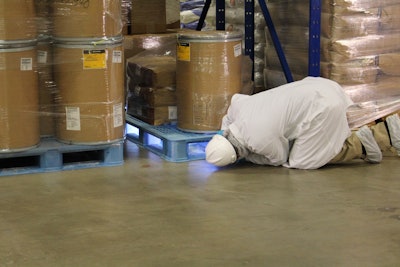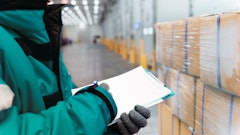
As one may suspect, there are multiple components in a rodent management program, including sanitation, vegetation management, rodent resource reduction and pest exclusion.
But, let’s first focus on the crucial elements in preventing rodent intrusion and exclusion, the common areas for rodent entry and some of the tools and techniques used to keep these pests out.
Personnel doors
Due to the wear and tear of the seals at the threshold, personnel doors provide a common entry point for rodents. This pest needs a relatively small amount of space to enter a facility. In fact, a rat requires a half-inch-sized opening to enter and a mouse only needs a quarter of an inch. Due to this, it is vital doors are accessed frequently to ensure there are no gaps allowing these pests in.
One easy way to assess doors for gaps is to look at the base of the door from the interior and check if light is visible. If light is visible, the preferred rodent proofing seals to use are rubber encased steel fabric or high-density brush-style sweeps. There are also some commercially available seals that combine both the rubber-encased stainless steel and a brush for added protection. It is important to avoid the use of thinner rubber, vinyl and neoprene door sweeps as they are less durable and more prone to weather and sunlight damage.
Rubber-encased steel fabric sweep offer durability and the inability for rodents to gnaw through the stainless-steel mesh. In addition, rubber seals are preferred over brushes because they are less likely to collect food spills, debris and dirt, and are also easier to clean. Whatever material is used, it should be designed for pest proofing and not just weather stripping for temperature control.
When choosing the door sweeps best for the facilities, keep in mind the size of the door. Personnel doors in commercial facilities are normally 36-48 inches wide with some door sweeps pre-cut to fit these lengths. Pre-cut door sweep kits make installation easier; however, they must cover the bottom corners of the doors, so it stays well-sealed and not vulnerable to pest entry. Double doors used for pedestrian traffic have some additional challenges. There is often a vertical gap where the doors meet at the center. This gap can be anywhere along the length of the door closure or just at the base and can provide entry for rodents and insects. However, special seals, called astragal seals, can be used to pest proof this opening.
Overhead doors and dock doors
Just like personnel doors, overhead doors can be a common rodent entry point. Their repeated opening and closing make them susceptible to rodents as well as forklift damage that they are often subject to, which can leave doors accessible to pests. Similar to personnel doors, door sweeps are equally important for ground-level overhead doors and dock doors. Ground-level overhead doors are the highest risk for rodent entry. Rodents moving along at ground level can easily detect food odors and warmth escaping from poorly sealed doors in their path.
The second most common door entry point for rodents is ramp doors. Ground level doors and ramp doors should be closely examined during pest inspections to ensure they continue to be well-sealed. Unfortunately, overhead doors are more difficult to seal because of their width, height and accessibility. There may be locking devices or other hardware near the path of the seal, which further complicates installation. This is why proper fit seals are essential to pest proofing. The sides and tops of overhead doors need to have high-density brush sweeps or stainless-steel enveloped seals in place on all four sides to prevent pest entry. In addition to the interior seals, supplemental exterior seals are required to help protect the facility when the door is open for trucks unloading and loading. Exterior pads around the sides and top of the door are designed to create a buffer between trailers. These pads must be maintained as its cushions are prone to damage due to weather and truck movement. As a result, there can be sizable gaps when these cushions are missing or in poor shape, allowing pest entry points.
Another area of note is the dock plate ramp. Oftentimes, there is a gap at the dock plate ramp used to bridge the dock plate to the trailer. Portable draft blockers can be used to seal this gap. Unfortunately, they must be moved by staff each time a new trailer arrives and one leaves, so it is vital staff are well trained on their importance and placement.
Dock plates
The side edges around dock plates are prone to rodent entry as their seals undergo wear and tear during daily loading and unloading of trailers. The corners and hinged back seal are both difficult to seal and maintain as the brushes are particularly prone to food accumulation from spills. Some facilities turn to sweeps installed along the dock levelers as they are normally tack welded or screwed into the sides of the dock leveler deck and offer a better pest prevention method.
One area that is often overlooked in this area as a potential pest threat are the openings used to house the pull chains in the dock plate. There are special sealing devices available that can be attached to the chains to raise the plate. These devices cover the chain pull open when the chain is retracted. They are commercially available in three sizes to accommodate the different sized openings in the dock plate.
Inspection of incoming goods
Although both mice and rats can enter facilities on shipments, mice are the more common stowaway pest. House mice can derive sufficient moisture from the foods they consume but also have a need for free water to drink. They also seek shelter oftentimes using cardboard and other packaging materials provided in shipments for nesting. These nests are typically constructed out of view and in the pallet stack interior. Due to this, mice can nest and feed in a pallet of food undetected by trap monitors for weeks.
There is an educational component to the inspection of incoming goods. Staff must be trained on all procedures and understand how to recognize signs of rodent activity. It doesn’t help to keep door seals in place if staff leave the doors open. Once the door seals are in place, it’s important to educate staff on why doors should be closed when not in use. If the door needs to be left open for ventilation purposes, facilities must install tight fitting screens. To monitor staff for compliance with door closure policies, door alarms and sensors may be helpful in assuring policies are followed. Education components should go beyond shipping and receiving staff. All employees should receive education on basic pest identification and the conditions that support pest activity, such as leaving doors open. Their actions can impact the pest management program and play an important role in prevention. There should be an established reporting system for staff to use in communicating pest activity and training provided on the proper reporting procedures.
Summary
Door and dock plate exclusion devices play an important role in pest prevention programs, and pest professionals should be well-versed in proper installation to prevent pest activity. It is important to understand that these devices do more than just prevent pests - they decrease energy consumption, lower noise emissions and increase building hygiene by preventing dirt and dust intrusion. Maintaining sealed doors requires effort but can provide a variety of essential food safety and environmental building benefits. The two additional components of staff education and inspection of shipments are just as critical and complements pest proofing efforts. Having a well-trained staff in inspections, recognition of rodent signs and the importance of keeping doors closed can pay dividends in pest prevention. It is important to check pallets and stacks for droppings, gnawed packages and nesting material when the material arrives, preferably before it is unloaded from the truck. Any shipments containing rodent evidence should be rejected.


















